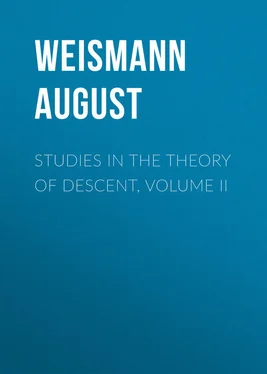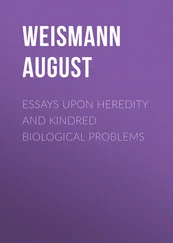August Weismann - Studies in the Theory of Descent, Volume II
Здесь есть возможность читать онлайн «August Weismann - Studies in the Theory of Descent, Volume II» — ознакомительный отрывок электронной книги совершенно бесплатно, а после прочтения отрывка купить полную версию. В некоторых случаях можно слушать аудио, скачать через торрент в формате fb2 и присутствует краткое содержание. Жанр: foreign_antique, foreign_prose, на английском языке. Описание произведения, (предисловие) а так же отзывы посетителей доступны на портале библиотеки ЛибКат.
- Название:Studies in the Theory of Descent, Volume II
- Автор:
- Жанр:
- Год:неизвестен
- ISBN:нет данных
- Рейтинг книги:4 / 5. Голосов: 1
-
Избранное:Добавить в избранное
- Отзывы:
-
Ваша оценка:
- 80
- 1
- 2
- 3
- 4
- 5
Studies in the Theory of Descent, Volume II: краткое содержание, описание и аннотация
Предлагаем к чтению аннотацию, описание, краткое содержание или предисловие (зависит от того, что написал сам автор книги «Studies in the Theory of Descent, Volume II»). Если вы не нашли необходимую информацию о книге — напишите в комментариях, мы постараемся отыскать её.
Studies in the Theory of Descent, Volume II — читать онлайн ознакомительный отрывок
Ниже представлен текст книги, разбитый по страницам. Система сохранения места последней прочитанной страницы, позволяет с удобством читать онлайн бесплатно книгу «Studies in the Theory of Descent, Volume II», без необходимости каждый раз заново искать на чём Вы остановились. Поставьте закладку, и сможете в любой момент перейти на страницу, на которой закончили чтение.
Интервал:
Закладка:
August Weismann
Studies in the Theory of Descent, Volume II
I. Larva and Imago vary in Structure independently of each other
It would be meaningless to assert that the two stages above mentioned were completely independent of one another. It is obvious that the amount of organic and living matter contained in the caterpillar determines the size of the butterfly, and that the quantity of organic matter in the egg must determine the size of the emergent larva. The assertion in the above heading refers only to the structure; but even for this it cannot be taken as signifying an absolute, but only a relative independence, which, however, certainly obtains in a very high degree. Although it is conceivable that every change of structure in the imago may entail a correlative change of structure in the larva, no such cases have as yet been proved; on the contrary, all facts indicate an almost complete independence of the two stages. It is quite different with cases of indirect dependence, such, for example, as are brought about by ‘nurse-breeding.’ This phenomenon is almost completely absent in Lepidoptera, but is found in Diptera, and especially in Hymenoptera in every degree. The larvæ of ichneumons which live in other insects, require (not always, but in most instances) that the female imago should possess a sharp ovipositor, so that in this case also the structure and mode of life of the larva influences the perfect insect. This does not depend, however, on inherent laws of growth (correlation), but on the action of external influences, to which the organism endeavours to adapt itself by natural selection.
I will now let the facts speak for themselves.
It is shown by those species in which only one stage is di- or polymorphic that not every change in the one stage entails a corresponding change in the other. Thus, in all seasonally dimorphic species we find that the caterpillars of butterflies which are often widely different in the colour and marking of their successive generations are absolutely identical. On the other hand, many species can be adduced of which the larvæ are dimorphic whilst the imagines occur only in one form (compare the first and second essays in this volume).
There are however facts which directly prove that any one stage can change independently of the others; I refer to the circumstance that any one stage may become independently variable – that the property of greater variability or of greater constancy by no means always occurs in an equal degree in all the three stages of larva, pupa, and imago, but that sometimes the caterpillar is very variable and the pupa and imago quite constant. On the other hand, all three stages may be equally variable or equally constant, although this seldom occurs.
If variability is to be understood as indicating the period of re-modelling of a living form, whether in its totality or only in single characters or groups of characters, from the simple fact of the heterochronic variability of the ontogenetic stages, it follows that the latter can be modified individually, and that the re-modelling of one stage by no means necessarily entails that of the others. It cannot however be doubted that variability, from whatever cause it may have arisen, is in all cases competent to produce a new form. From the continued crossing of variable individuals alone, an equalization of differences must at length take place, and with this a new, although not always a widely deviating, constant form must arise.
That the different stages of development of a species may actually be partly variable and partly constant, and that the variable or constant character of one stage has no influence on the other stages, is shown by the following cases, which are, at the same time, well adapted to throw light on the causes of variability, and are thus calculated to contribute towards the solution of the main problem with which this investigation is concerned.
When, in the following pages, I speak of variability , I do not refer to the occurrence of local varieties, or to variations which occur in the course of time, but I mean a high degree of individual variability – a considerable fluctuation of characters in the individuals of one and the same district or of the same brood. I consider a species to be constant, on the other hand, when the individuals from a small or large district differ from one another only to a very slight extent. Constant forms are likewise generally, but not invariably, such as are poor in local varieties, whilst variable forms are those which are rich in such variations. Since the terms “variable” and “constant” are but relative, I will confine myself to the most extreme cases, those in which the individual peculiarities fluctuate within very wide or very narrow limits.
As no observations upon the degree of variability shown by a species in the different stages of its development were available, I was obliged to fall back upon my own, at least so far as relates to the larval and pupal stages, whilst for the imaginal stage the wide experience of my esteemed friend Dr. Staudinger has been of essential service to me.
Let us in the first place confine our attention to the three chief forms which every Lepidopteron presents, viz. larva, pupa, and imago. With respect to the constancy or variability of these three forms, we actually find in nature all the combinations which are theoretically conceivable.
(1.) There are species which possess a high degree of constancy in all three stages, such, for example, as Limenitis Camilla , Pieris Brassicæ , 1 1 [The slight variability in the colour of this pupa, opens up the interesting question of the photographic sensitiveness of this and other species, which is stated to cause them to assimilate in colour to the surface on which the larva undergoes its final ecdysis. Some experiments upon this subject have been recorded by Mr. T. W. Wood, Proc. Ent. Soc. 1867, p. xcix, but the field is still almost unexplored. R.M.]
Sphinx Ligustri , and Euchelia Jacobææ .
(2.) There are species showing a high degree of variability in all three stages. This case must be of rare occurrence, as I am only able to adduce Araschnia Prorsa-Levana , a fact which arises from the circumstance that the pupal stage is, as a rule, but seldom variable.
(3.) There are species which are variable in two stages and constant in the third. To this class, for example, belongs Smerinthus Tiliæ , of which the larva and imago are very variable, whilst the pupa is quite constant. The same is the case with Lasiocampa Pini , the well-known fir moth. Many butterflies show this same phenomenon in other combinations, such, for instance, as Vanessa Urticæ and Polychloros , in which the larva and pupa are very variable, and the imago very constant. In a less degree the same is also the case with Vanessa Atalanta , whilst in Pieris Napi the pupa and imago are variable, and the caterpillar remarkably constant, this likewise being the case with the local form Bryoniæ , which, according to my theory, is to be regarded as the parent form of Napi (See Part I. of the present volume).
(4.) There are species which are constant in two stages, and variable only in the third. Thus, a few species can be found in which the larva and pupa are constant and the imago variable. This is the case with Saturnia Yamamai , the imago of which is well known to present numberless shades of colour, varying from light yellow to greyish black, whilst the green caterpillar shows only slight individual differences of marking, and scarcely any differences of colour. The pupa of this species is quite constant. Arctia Caja and Hebe , and Chelonia Plantaginis belong to this same category.
Читать дальшеИнтервал:
Закладка:
Похожие книги на «Studies in the Theory of Descent, Volume II»
Представляем Вашему вниманию похожие книги на «Studies in the Theory of Descent, Volume II» списком для выбора. Мы отобрали схожую по названию и смыслу литературу в надежде предоставить читателям больше вариантов отыскать новые, интересные, ещё непрочитанные произведения.
Обсуждение, отзывы о книге «Studies in the Theory of Descent, Volume II» и просто собственные мнения читателей. Оставьте ваши комментарии, напишите, что Вы думаете о произведении, его смысле или главных героях. Укажите что конкретно понравилось, а что нет, и почему Вы так считаете.












